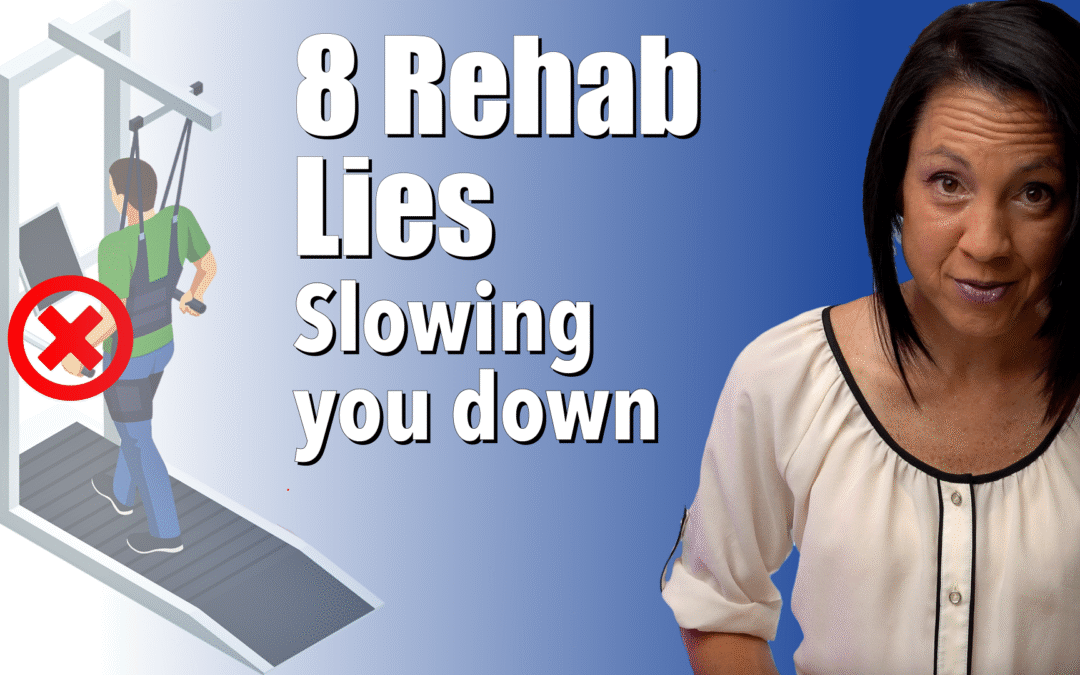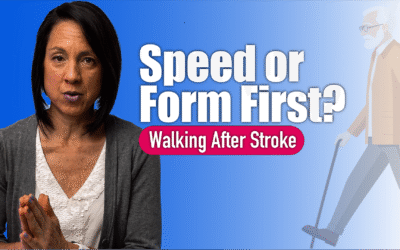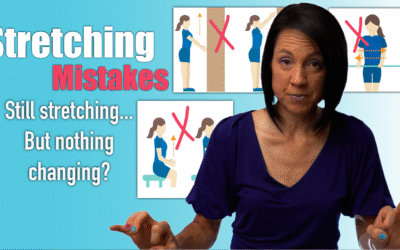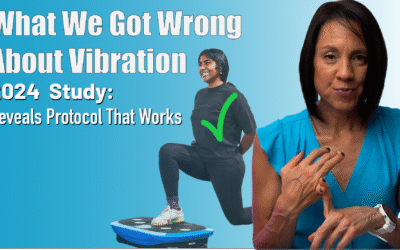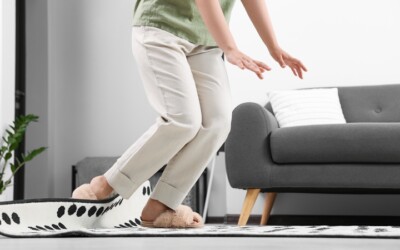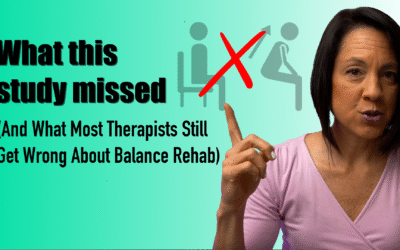8 Neuro Rehab Myths That Are Holding You Back (And What to Do Instead)
Debunking Common Myths About Neurologic Recovery
If you’ve ever been told that your recovery after a neurologic injury has an expiration date, or if your physical therapy has focused only on walking speed, this post is for you. Outdated beliefs in the healthcare system can hold people back from true recovery. We’re breaking down the most common myths and revealing the truth that can help you take ownership of your rehab journey.
Myth 1: Recovery Stops After 18 Months
Many patients are told there’s a point after which no new progress is possible. This is false.
The Truth: Your brain can rewire itself throughout your entire life. Neuroplasticity doesn’t stop after six months, a year, or even 18 months. Many patients make progress years after their injury, gaining new movement and independence. Supportive caregivers, repetition, and a growth mindset make this recovery possible.
Myth 2: Walking Speed is the Ultimate Goal
Many traditional therapists focus heavily on gait speed, often citing 1.4 meters per second as a benchmark.
The Truth: While walking speed has value (it relates to community mobility and fall risk), it’s not the most important measure of recovery. Overemphasis on speed can create harmful compensatory patterns, making it harder to restore movement on the affected side. The real goal should be quality of movement, not just speed.
Myth 3: “No Pain, No Gain” or “Pain means stop”
Pain advice is confusing. Some say push through it, others say avoid it entirely.
The Truth: Both extremes are misleading. Mild, tolerable discomfort is necessary to retrain your nervous system, but pushing through too much pain can increase spasticity and fear. On the other hand, avoiding all pain can stall progress. The key is finding your personal pain threshold where you can work without triggering negative emotional reactions.
Myth 4: Expensive Equipment is Required for Recovery
Robotic devices, subscriptions, and high-tech therapy tools are often marketed as essential.
The Truth: Most progress comes from intentional & repetitive practice, not gadgets. Many expensive tools end up unused in closets. In most cases, a skilled therapist and simple tools are far more valuable.
Myth 5: Assistive Devices and Braces Are Crutches
Canes, AFOs, and braces are sometimes stigmatized as signs of dependency.
The Truth: Devices like AFOs or canes are not signs of weakness. They are actually tools that support recovery, reduce spasticity, promote safer walking, and improve quality of life. The real risk comes from abandoning them too early, which can worsen gait deviations.
Tip: Avoid long-term reliance on HEMI walkers.
Myth 6: If You Can’t Do It Perfectly, Don’t Do It At All
Some therapists push for perfect movement, while others focus solely on speed.
The Truth: Waiting for perfection is counterproductive. Safe, consistent practice, imperfect or not, builds confidence, strength, and neuroplasticity. Even small mistakes help the brain learn and self-correct. Avoiding activity altogether increases sedentary time, which raises the risk of secondary health problems.
Myth 7: Recovery Only Happens in Therapy Sessions
Therapy sessions are valuable, but they are not enough on their own.
The Truth: Progress isn’t limited to the clinic. True neuroplastic change requires consistent repetition outside of therapy as well. The real breakthroughs often happen at home with daily, intentional practice. Therapists can guide you, but ownership of recovery happens in your everyday routines.
Myth 8: Recovery Means Returning to How You Were Before
Many people expect steady progress, but recovery often comes in fits and starts.
The Truth: Recovery is not always about going back to your “old normal.” It’s about creating a new normal where you can regain independence, adapt, and thrive. Even if some functions don’t return exactly as they were, you can still build meaningful strength, movement, and confidence to live fully.
Final Thoughts
Neurologic recovery is not limited by time, gadgets, or perfection. By letting go of outdated myths, you can embrace a balanced, realistic approach that supports lifelong progress. Remember: your brain is always capable of change, and with the right mindset, tools, and support, you can move forward in your recovery journey.
Articles you may be interested in
Is Your Neuro Rehab Helping Your Recovery, or Making Things Worse?
The Real Impact of Neuro Rehab on Recovery https://youtu.be/YDgQc4p_atE Recovering after a stroke often involves long hours of rehabilitation. Neuro rehab programs are designed to retrain the brain and body, helping survivors regain independence. Understanding...
How Short Bursts of Exercise Boost Brain Healing
HIIT for Stroke Recovery Boost brain rewiring, improve movement, and speed recovery with short bursts of exercise. https://youtu.be/4SgXN2uRX8g If you’ve been on your stroke recovery journey for a while, you’ve probably heard the word neuroplasticity. Neuroplasticity...
Stretching Spastic Muscles: 8 Mistakes to Avoid
8 Common Stretching Mistakes in Stroke Recovery Why Your Stretching Might Be Making Spasticity Worse https://youtu.be/bBsM34HROYY If you’re dealing with spasticity after a neurologic injury, stretching might not be as straightforward as it seems. In fact, doing it the...
New Study: Vibration Plates Boost Balance After Stroke
It Just Vibrates… So Why Are Stroke Survivors Getting Better? The Truth Behind the Research https://youtu.be/GZgGsMjEgJQ When vibration plates first became popular, they reminded many of us of those old 1980s machines that promised to "shake" the fat away. Naturally,...
Walking “Tips” that Sabotage Post-Stroke Progress
Recovering from Stroke? Don’t Let These 7 Walking Mistakes Set You Back Better Walking Starts by Avoiding These Mistakes https://youtu.be/_nkjHLdOeLc Recovering your walking ability after a stroke is an incredible accomplishment. You’ve put in the work. Strengthening...
The Hidden Reason Your Walking Feels Off After Stroke Rehab
The Missing Link in Stroke Rehab: Why Strength Isn’t Enough How Plyometric Exercises Can Improve Your Post-Stroke Walking https://youtu.be/0xzcgTifCiM Recovering from a stroke is a journey that takes patience, effort, and persistence. Maybe you’ve been faithfully...
Struggling with Shoulder Pain After a Stroke? Here’s What Works
Why Does My Shoulder Hurt After a Stroke?Understanding the 6 Most Common Causes and What You Can Actually Do About Them Let’s be real — if you’re recovering from a stroke and your shoulder still hurts, it can feel really defeating. Especially if you’ve been doing “all...
Still Feeling Weak After Stroke? This Might Be Why
Doing the exercises… but still not getting stronger?You’re walking. You’re moving. Maybe even getting stronger.But everything still feels hard. Like walking across a room takes full concentration. Or standing up while talking feels like solving rocket science....
Stroke Recovery: Spasticity vs. Adaptive Shortening vs. Contracture
Stroke Recovery: Spasticity vs. Adaptive Shortening vs. Contracture Muscle tightness after stroke is common and can be the greatest barrier to restoring normal arm and leg movement. But not all tightness is the same. To treat it effectively, you need to understand...
Why Eccentric Control Might Be the Missing Link in Your Stroke Recovery
Why Eccentric Control Might Be the Missing Link in Your Stroke Recovery After a stroke, movement rarely returns the way we’d like. Instead of smooth, controlled motion, you get stiffness... or those annoying synergy patterns—where every muscle seems to fire at once....

